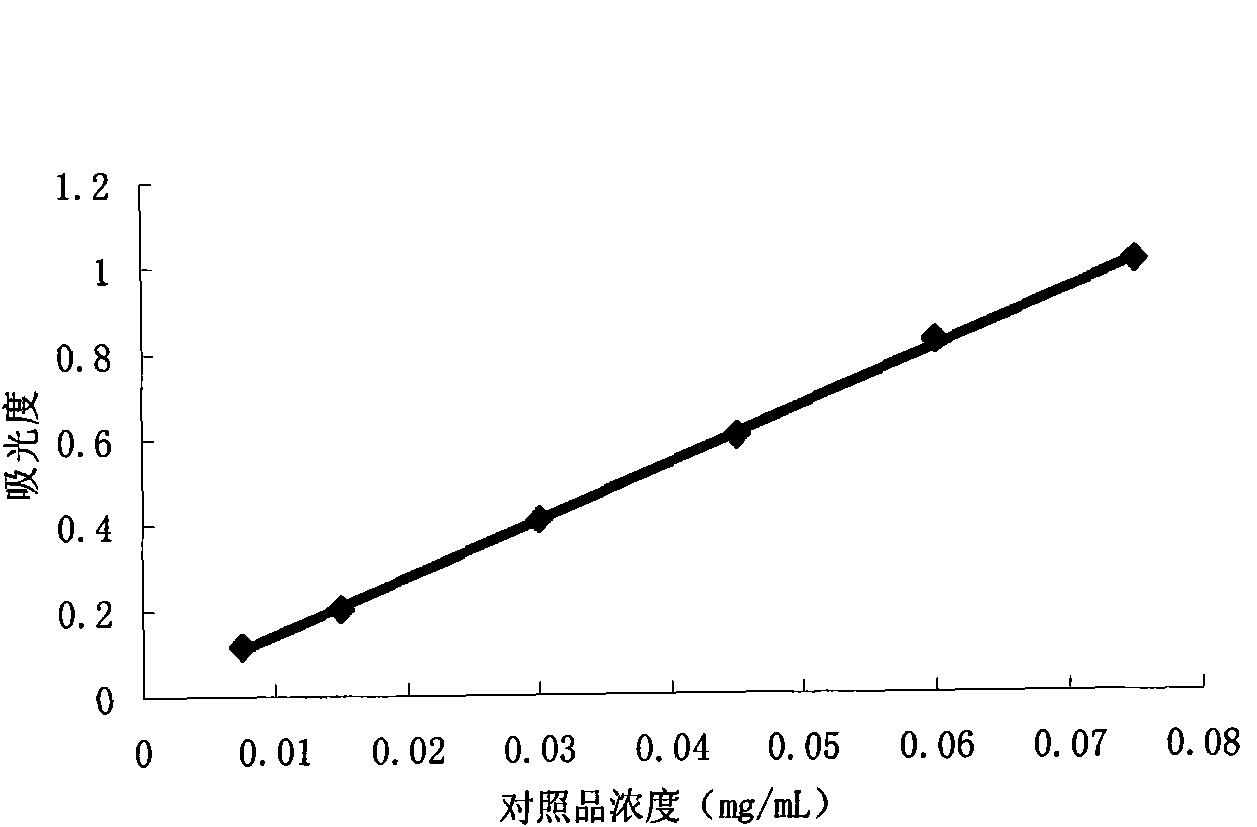Method for extracting general flavones from bamboo leaves
A technology of total flavonoids and bamboo leaves, applied in the direction of organic chemistry, can solve the problems of high cost and large loss of active ingredients, and achieve the effect of low cost, simple process operation, cost safety and non-toxicity
- Summary
- Abstract
- Description
- Claims
- Application Information
AI Technical Summary
Problems solved by technology
Method used
Image
Examples
example 1
[0021] 1. Extract total flavonoids from bamboo leaves
[0022] (1) Do the preparatory work earlier, that is, bamboo leaves are dried and pulverized into coarse powder; getting an equal amount of cellulase and pectinase and adding water to prepare a compound enzyme solution with a concentration of 0.1%; getting chitosan 0.8g, added to 80mL concentration of 1% acetic acid solution to make a chitosan colloid solution with a chitosan concentration of 1%, and set aside; take 4g of 101 fruit juice clarifier, add it to 80mL distilled water to make a concentration of 101 fruit juice clarifier It is 5% aqueous solution of 101 fruit juice clarifying agent, and it is reserved.
[0023] (2) Take 1000g of bamboo leaf powder, add 15 times of compound enzyme solution, then adjust the pH value of the solution to 5.0, then ultrasonically (50KHZ, 160W) at 50°C for 1.0h, then rapidly heat up to 90°C, keep Inactivate the enzyme for 5 minutes, filter, and concentrate the filtrate under reduced pr...
example 2
[0031] (1) Bamboo leaf is dried and ground into coarse powder; Get equal amount of cellulase and pectinase and add water and be prepared into the compound enzyme solution that concentration is 0.15%; Prepare the chitosan concentration by the same method of example 1 as 1% chitosan colloid solution and 101 fruit juice clarifying agent concentration are 5% 101 fruit juice clarifying agent aqueous solution, standby.
[0032] (2) Take 1000g of bamboo leaf powder, add 10 times of compound enzyme solution, then adjust the pH value of the solution to 4.5, then ultrasonically (50KHZ, 160W) at 40°C for 0.5h, then rapidly heat up to 90°C, keep Inactivate the enzyme for 5 minutes, filter, and concentrate the filtrate under reduced pressure to a relative density of 1.12 (60°C).
[0033] (3) At 60°C, first add 80 mL of chitosan colloid solution, stir well, then add 80 mL of 101 fruit juice clarifier aqueous solution, stir well, let stand overnight, centrifuge, and take the supernatant.
...
example 3
[0036] (1) Bamboo leaf is dried and ground into coarse powder; Get equal amount of cellulase and pectinase and add water and be prepared into the compound enzyme solution that concentration is 0.05%; Prepare the chitosan concentration by the same method of example 1 as 1% chitosan colloid solution and 101 fruit juice clarifying agent concentration are 5% 101 fruit juice clarifying agent aqueous solution, standby.
[0037] (2) Take 1000g of bamboo leaf powder, add 20 times of compound enzyme solution, then adjust the pH value of the solution to 6.0, then ultrasonically (50KHZ, 160W) at 60°C for 1.5h and then rapidly heat up to 85°C, keep Inactivate the enzyme for 5 minutes, filter, and concentrate the filtrate under reduced pressure to a relative density of 1.12 (60°C).
[0038] (3) At 60°C, first add 80 mL of chitosan colloid solution, stir well, then add 80 mL of 101 fruit juice clarifier aqueous solution, stir well, let stand overnight, centrifuge, and take the supernatant. ...
PUM
 Login to View More
Login to View More Abstract
Description
Claims
Application Information
 Login to View More
Login to View More - R&D
- Intellectual Property
- Life Sciences
- Materials
- Tech Scout
- Unparalleled Data Quality
- Higher Quality Content
- 60% Fewer Hallucinations
Browse by: Latest US Patents, China's latest patents, Technical Efficacy Thesaurus, Application Domain, Technology Topic, Popular Technical Reports.
© 2025 PatSnap. All rights reserved.Legal|Privacy policy|Modern Slavery Act Transparency Statement|Sitemap|About US| Contact US: help@patsnap.com

